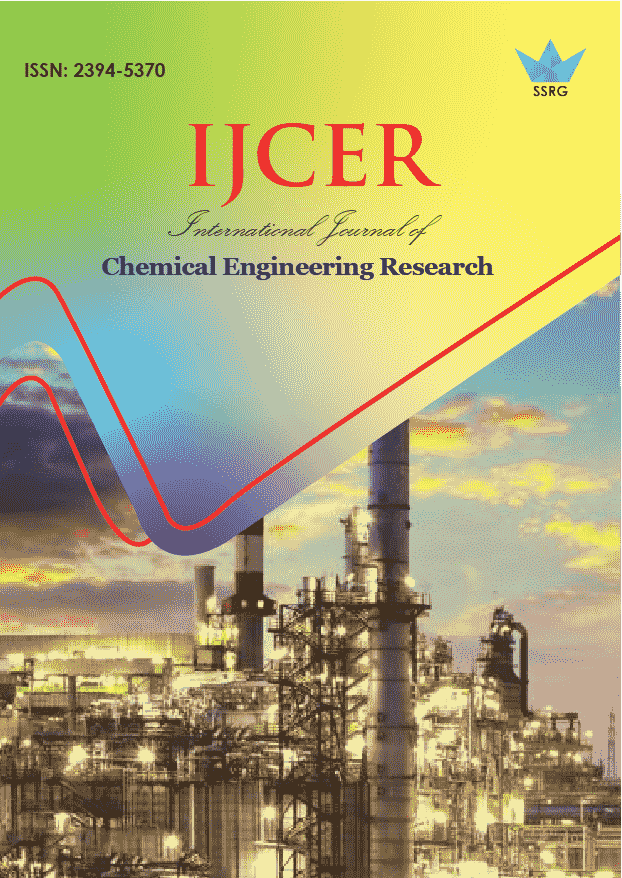Modelling and Evaluation of the Effect of Temperature on the Rheological Properties of Drilling Mud Formulated with Local Barite

| International Journal of Chemical Engineering Research |
| © 2021 by SSRG - IJCER Journal |
| Volume 8 Issue 1 |
| Year of Publication : 2021 |
| Authors : Nnadi Chidiebere Ngozi, Oduola Mujeeb Koyejo, Joel Ogbonna Friday |
How to Cite?
Nnadi Chidiebere Ngozi, Oduola Mujeeb Koyejo, Joel Ogbonna Friday, "Modelling and Evaluation of the Effect of Temperature on the Rheological Properties of Drilling Mud Formulated with Local Barite," SSRG International Journal of Chemical Engineering Research, vol. 8, no. 1, pp. 22-29, 2021. Crossref, https://doi.org/10.14445/23945370/IJCER-V8I1P104
Abstract:
This research paper assesses the effect of temperature on the rheological properties of Water-Based and Oil-Based Muds. The Muds were formulated with locally sources barite from 5 locations in Nigeria.Third order polynomial models have been considered to model the rheological properties as a function of SG (Specific gravity) which were generated using least square method and regressed with the Excel GRG (Generalized Reduced Gradient) Non-Linear Forward derivative solver. The absolute mean percentage error of the model data and measured data were calculated for all rheological properties and WBM 10” Gel strength had the highest error of 6.578% followed by OBM Yield Point of 4.443%. WBM Plastic viscosity showed the least error of 0.315%, seconded by WBM 10’ Gel strength with error of 0.339%. Findings from this work indicated that barites Samples B3 and B5 are good barites for WBM formulation as their rheology withstood increasing temperature the most and B4 is better for OBM formulation. Also, B1 and B2 will be good for OBM formulation if beneficiated to increase its SG and remove impurities.
Keywords:
Barite, Modelling, Oil-based mud, Rheology, Water based-mud.
References:
[1] Olatunde A .O., M. A. Usman, O. A. Olafadehan, T. A. Adeosun, O. E. Ufot/Petroleum & Coal 54(1) (2012) 65-75,
[2] Khodja, M., Khodja-Saber, M., Canselier, J. P., Cohaut, N., and Bergaya, F., Drilling Fluid Technology: Performances and Environmental Considerations. Products and Services; from R&D to Final Solutions, Igor Fuerstner (Ed.),( 2010b) 307-211-1.
[3] OmoniyiO.Á., Mubarak S..Potential Usage of Local Weighting Materials in Drilling Fluid a Substitute to Barite., Int. J. Innov. Res. Dev., 3 (13) (2014) 491-501.
[4] Zamora, M. and Bell, R., Improved well-site test for monitoring barite sag. American Association of Drilling Engineers Conference, Houston. AADE-04-DFHO-19 (2004).
[5] Johnson, C.A.; Piatak, N.M.; Miller, M.M. Barite (Barium)., In Critical Mineral Resources of the United States—Economic and Environmental Geology and Prospects for Future Supply; U.S. Geological Survey: Reston, VA, USA, (2017).
[6] Emmanuel, E., Exploration and production of barite in Cross River to meet growing demand by international oil companies. Cross River Watch. Available from: http://crossriverwatch.com/2015/08/exploration-andproduction-of-barite-in-cross-river-to-meet-growing-demandby-international-oil-com. (2015).
[7] Baba Hamed, S.; Belhadri, M., Rheological properties of biopolymers drilling fluids.J. Pet. Sci. Eng67, (2009) 84−90.
[8] Bartlett, L.E., Effects of Temperature on the Flow Properties of Drilling Fluids. In Proc. SPE Annual Meeting of AIME, Houston, Texas, Paper 1861, (1967).
[9] Oden, M.I., Barite Veins in the Benue Trough: Field Characteristics, the Quality Issue and Some Tectonic Implications. Environ. Nat. Resour. Res. 2 (2012) 21.
[10] Sadek, Z. K., Ashraf, S.I and Marwan, M. E. Drilling Fluid Rheology and Hydraulics for Oilfields European Journal of Scientific Research, 57 (1) (2011) 6886.
[11] Herzhaft B. Rheological Properties of Drilling Muds in Deep Offshore Conditions, in Proc. SPE/IADC Drilling Conference, Amsterdam, Netherlands, (2001) 27.
[12] Igwilo K.C., IkoroGodspower, OkoliNnanna, Osueke G.O., Odo Jude, Anawe P.A.L., Modeling the Effects of Temperature on Oil Base Mud Viscosity Using Polynomial equation. International Journal of Petroleum and Petrochemical Engineering (IJPPE) 3( 2) (2017), 16-22.
[13] Ahmed S. Mohammed., Effect of temperature on the rheological properties with shear stress limit of iron oxide nanoparticle modified bentonite drilling muds, Egyptian Journal of Petroleum.26 (2016).
[14] Ebikapaye, JP ., Effects of Temperature on the Density of Water Based Drilling Mud, J. Appl. Sci. Environ. Manage, 22 (3) (2018) 406 – 408.
[15] Su WaiAungKhaing., Characterization and Performance of 70/30 and 90/10 OBM mud systems, Master’s Thesis, University of Stavanger, (2014)
[16] Allawi, Hasan&Najem, Mohammed &Sagger, Mohammed &Abd, Sajjad. Effect of Temperature on Drilling Mud. Journal of Physics: Conference Series, 1279 (2019) 012054.
[17] National Driller. Properties of Water-based Muds, E-publishing by Army Corps of Engineers, (2007) 1-3.
[18] Friedheim, J., Young, S., Stefano, G. D., Lee, J., and Guo, Q., Nanotechnology for Oilfield Applications-Hype or Reality, SPE International Oilfield Nanotechnology Conference held in Noordwijk, The Netherlands. (2012) 12-14.
[19] SuhascaryoNur, NawangsidiDody and Handayani Sri Rejeki Laboratory Study of High Temperature Additive to Rheology Properties of Drilling Mud, under Dynamic Conditions, UPN Veteran, Ring Road Utara, CondongCatur SWK III, Sleman, Jogjakarta, 55584, Indonesia
[20] API Recommended Practice 13B API Recommended Practice for field testing drilling fluids (5thedition), Washington: API, 13 B (2005) 9-10.
[21] Rheological Models.Schlumberger, http://www.glossary.oilfield.slb.com/.Downloaded 2 July , (2007).
[22] Kelessidis V.C., Gelation of water-bentonite suspensions at high temperature and rheological control with lignite addition, Appl. ClaySci, 36 (2007) 221-230 [23] Igwilo,K.C.,Uwaezuoke,N.,Okoli, N. et al., Beneficiation of Nigerian bentonite using local materials. J Petrol Explor Prod Technol 10, (2020) 3399–3407. https://doi.org/10.1007/s13202-020-00956-8.
[24] Akintunde A Experimental determination of the effect of temperature and pressure on the density of water based mud (unpublished project), (2012)
[25] American Petroleum Institute, Recommended Practice on the Rheology and Hydraulics of OilWell Drilling Fluids, API RP 13D, 3rd Edition, Washington, DC, June, (1995).
[26] Jemimah Jehopio, George William Nyakairu., Optimum Biocide Concentration Required to Preserve the Highest Amount of Sucrose During Mud Filtration, SSRG International Journal of of Chemical Engineering Research 4.2 (2017) 10-17.

 10.14445/23945370/IJCER-V8I1P104
10.14445/23945370/IJCER-V8I1P104